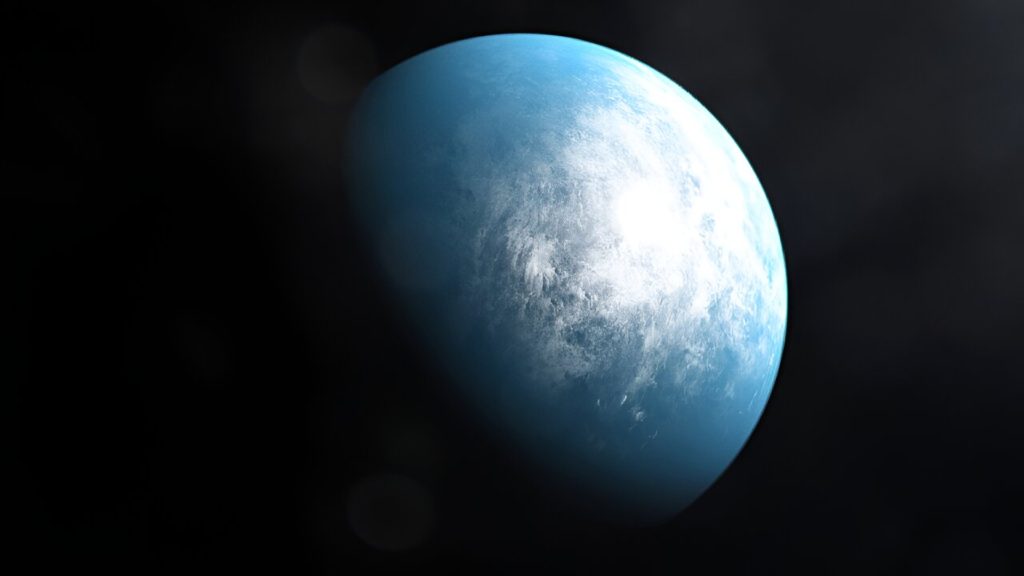An artist’s illustration of a planet outside our solar system (not LHS 1140 b).
Scientists using the James Webb Space Telescope say a planet relatively close to Earth could be discovered as the first planet outside our solar system with a liquid ocean that could potentially support life.
More than 5,000 exoplanets have been discovered so far, but only a handful lie in the “Goldilocks zone” — a region not too hot or cold that could support liquid water, a key ingredient for life.
The exoplanet LHS 1140 b is Habitable ZoneIt was first discovered in 2017 and has since been subjected to extensive scrutiny.
It is 48 light years away from Earth, which is the equivalent of more than 450 trillion kilometers (280 trillion miles), a relatively small distance in the vast distances of the universe.
The exoplanet is a small gas giant known as a “mini-Neptune” whose atmosphere is thought to be too thick with hydrogen and helium to support extraterrestrial life.
But new observations from the Webb Telescope confirm that the exoplanet is in fact a rocky “super-Earth.”
The planet is 1.7 times larger than Earth, but 5.6 times more massive, according to a study published late Wednesday. Astrophysical Journal Letters.
“The best bet” for the marine world
The Webb Telescope was able to analyze the planet’s atmosphere as it passed in front of its star.
No signs of hydrogen or helium were found, ruling out the possibility that the planet is a mini-Neptune.
Study co-author Martin Turbé of France’s CNRS scientific research center told AFP that the planet’s density shows “there is indeed a lot of water present.”
It could be a really huge amount of water.
The water in Earth’s oceans makes up just 0.02% of Earth’s mass, but it’s estimated that 10-20% of the mass of exoplanets is water.
Whether this water is liquid or ice depends on the planet’s atmosphere.
“We don’t have direct evidence that it has an atmosphere, but several factors point in that direction,” Tarbet said.
“Of all currently known temperate exoplanets, LHS 1140 b may be our best option for indirectly confirming the presence of liquid water on the surface of an alien world in the future,” said Charles Cadieux, a doctoral student at the University of Montreal and lead author of the study.
On the plus side, the planet is gently warmed by a red dwarf star that’s one-fifth the size of the Sun.
Tarbet said the exoplanet’s surface temperature should be quite similar to that of Earth and Mars.
The presence of gases such as carbon dioxide will play a key role in determining whether a planet is covered in ice or water.
Bullseye Ocean
One possibility is that the surface is mostly ice, but the vast expanses are Liquid Ocean The area where a planet is most exposed to the heat of its star.
Models suggest that the ocean could have a diameter of around 4,000 kilometres, roughly half the surface area of the Atlantic Ocean.
Alternatively, liquid water could be hidden beneath a thick shell of ice, as on the moons Ganymede, Enceladus, and Europa that orbit Jupiter and Saturn.
Webb’s equipment found signs suggesting “the presence of nitrogen,” Cadieux said, adding that further research is needed to confirm the findings.
Nitrogen is present everywhere on Earth and is thought to be another potential ingredient for life.
The researchers hope to get a few more precious hours of Webb telescope time to study LHS 1140 b in more detail.
It will take at least a year to determine if the exoplanet has an atmosphere, and possibly another two or three. carbon dioxideThe researchers estimated.
For more information:
Charles Cadiu et al., Transmission Spectroscopy of the Habitable Zone Exoplanet LHS 1140 b by JWST/NIRISS, arXiv (2024). Source: arxiv.2406.15136
© 2024 AFP
Quote: Nearby exoplanet may be first known ocean world: Webb Telescope (July 13, 2024) Retrieved July 14, 2024 from https://phys.org/news/2024-07-nearby-exoplanet-ocean-world-webb.html
This document is subject to copyright. It may not be reproduced without written permission, except for fair dealing for the purposes of personal study or research. The content is provided for informational purposes only.


